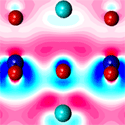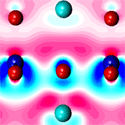One cannot polarize by strain alone
Ferroelectric materials, which have a switchable electric polarization, are already the basis of nonvolatile memory and electronic devices, but efforts to make these materials in thin-film form face the frustrating effects of depolarizing fields that counteract ferroelectricity.
Recent experiments have suggested that strain could be important for stabilizing thin-film ferroelectrics. Bulk strontium titanate, for example, is not ferroelectric, but thin films deposited on silicon (which has a different lattice structure than strontium titanate) develop a spontaneous electric polarization at room temperature. The possibility that strained strontium titanate, integrated into a silicon wafer, could be a ferroelectric is exciting, but whether the polarization is due to switchable ferroelecricity or some other effect has remained an open question.
Now, in a paper published in Physical Review Letters, Alexie Kolpak (now at the Massachusetts Institute of Technology) and collaborators at Yale University, Brookhaven National Laboratory, and Argonne National Laboratory, all in the US, have investigated the effect of the interface on the observed polarization of strontium titanate films grown on silicon. Using both synchrotron x-ray diffraction and first-principles calculations they argue that the interface creates a polarized ground state that has been mistakenly identified as proof of ferroelectricty. While the absence of a new type of room-temperature ferroelectricity in these films is disappointing, Kolpak et al.’s paper provides a useful guide toward understanding the interface in thin-film ferroelectrics, which will be essential for the construction of functional devices. – Daniel Ucko





